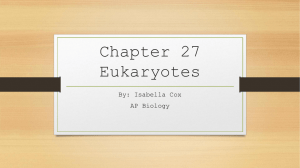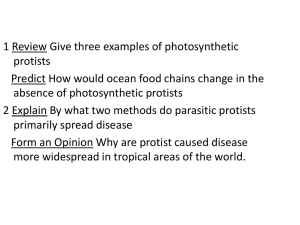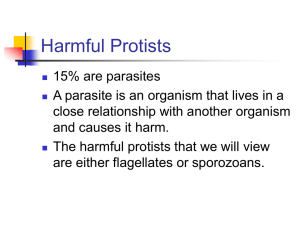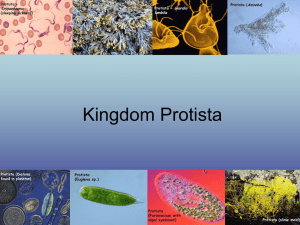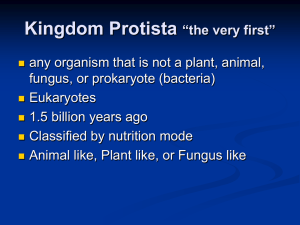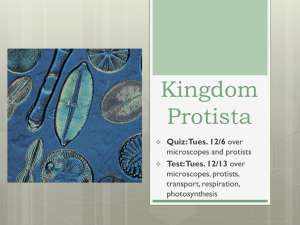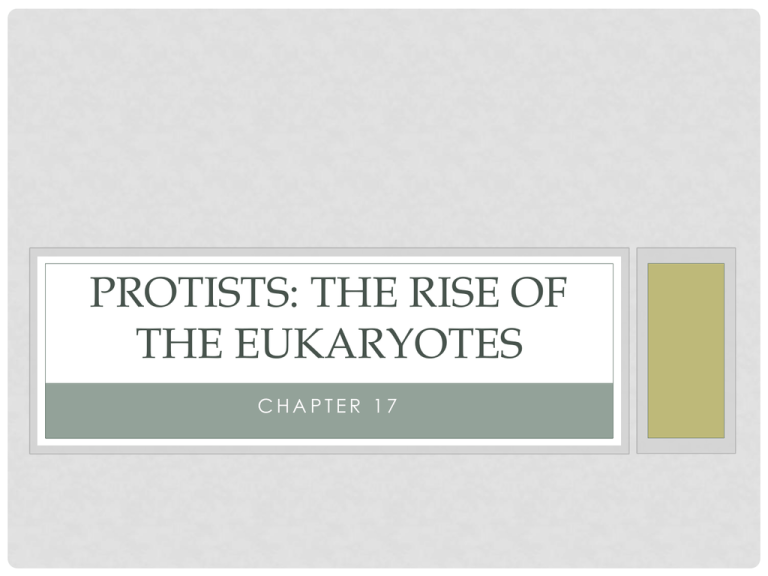
PROTISTS: THE RISE OF
THE EUKARYOTES
CHAPTER 17
ORIGIN OF EUKARYOTIC CELLS
• Eukaryotic cells appeared first around 1.7
billion years ago.
• Eukaryotic cells possess a nucleus.
• Some bacterial cells have infoldings of their
outer membranes extending into the interior.
• The endoplasmic reticulum (ER) and nuclear
envelope of eukaryotes is thought to have
evolved from this.
ORIGIN OF THE NUCLEUS AND
ENDOPLASMIC RETICULUM
Infolding of the
plasma membrane
Endoplasmic
reticulum (ER)
Plasma membrane
Nuclear
envelope
DNA
Nucleus
Cell wall
Prokaryotic cell
Prokaryotic ancestor
of eukaryotic cells
Plasma membrane
Eukaryotic cell
ORIGIN OF EUKARYOTIC CELLS
• The endosymbiotic theory is a widely
accepted explanation for the origin of
mitochondria and chloroplasts in eukaryotes
from bacteria.
• Present-day mitochondria and chloroplasts still
contain their own DNA.
• This DNA is remarkably similar in size and
character to the DNA of bacteria.
THE THEORY OF ENDOSYMBIOSIS
Internal
membrane
system
Aerobic
bacterium
Endosymbiosis
Mitochondrion
Ancestral eukaryotic cell
Eukaryotic cell
with mitochondrion
Photosynthetic
bacterium
Chloroplast
Endosymbiosis
Eukaryotic cell with chloroplast and mitochondrion
THE EVOLUTION OF SEX
• A profound difference between prokaryotes and
eukaryotes is that eukaryotes have the capacity for
sexual reproduction.
• Sexual reproduction involves two parents
contributing gametes to form the offspring.
• Gametes are usually formed by meiosis and are
haploid.
• The resulting offspring are diploid.
ASEXUAL REPRODUCTION
• But sexual reproduction is not the only way
that eukaryotes can reproduce.
• Many eukaryotes reproduce by asexual
reproduction, which is reproduction without
forming gametes.
• The offspring of asexual reproduction are
genetically identical to the parents.
• Many eukaryotes reproduce mainly by asexual
reproduction, switching to sexual reproduction
only during environmental stress.
REPRODUCTION AMONG PARAMECIA
Paramecium cells
(a)
Nuclei
Paramecium
cells
(b)
THE EVOLUTION OF SEX
• A different asexual strategy in eukaryotes is
parthenogenesis, the development of an
adult from an unfertilized egg.
• Many plants and marine fishes undergo a
form of sexual reproduction that does not
involve partners called self-fertilization and
involves one individual providing both male
and female gametes.
THE EVOLUTION OF SEX
• The advantages of sexual reproduction are
not immediately obvious.
• The segregation of chromosomes that occurs in
meiosis tends to disrupt advantageous
combinations of genes.
• Why should progeny not maintain a parent’s
already successful gene combinations?
THE EVOLUTION OF SEX
• Sexual reproduction may have evolved in
protists because the diploid cell stage allows
for chromosomal repair.
• Double-strand breaks in the DNA are induced by
desiccation.
• The environmental stress of drying out triggers the
diploid stage.
• Perhaps chromosome-pairing in the early stages
of meiosis evolved originally as a mechanism for
repairing double-strand damage.
• The undamaged version could be used as a
template to guide fixing of the damaged one.
THE EVOLUTION OF SEX
• Sexual reproduction is one of the most
important evolutionary innovations of
eukaryotes.
• It provides a means of shuffling genes,
creating genetic diversity.
• Genetic diversity is the raw material of
evolution.
• The greater the genetic diversity, the more
rapid the evolutionary pace.
THE EVOLUTION OF SEX
• The sexual life cycle involves the production
of haploid gametes by meiosis, followed by
the union of two gametes in sexual
reproduction.
• Eukaryotes are characterized by three major
types of sexual life cycles.
• Zygotic meiosis
• Gametic meiosis
• Sporic meiosis
THE EVOLUTION OF SEX
• In zygotic meiosis, the zygote formed by the
fusion of gametes is the only diploid cell.
• This type of sexual life cycle is common in many
algae.
• The zygote is the only cell that undergoes meiosis.
• Haploid cells occupy the major portion of the life
cycle.
THREE TYPES OF EUKARYOTIC
LIFE CYCLES: ZYGOTIC MEIOSIS
Key:
Diploid
Haploid
Haploid
cells
+
+
–
–
n
Meiosis
2n
Zygote
Haploid
individuals
–
n
+
Gametes
(a) Zygoticmeiosis
Syngamy
THE EVOLUTION OF SEX
• In gametic meiosis, the gametes are the
only haploid cells.
• This sexual life cycle is common to most animals.
• Meiosis produces the gametes.
• The diploid cells occupy the major portion of the
life cycle.
THREE TYPES OF EUKARYOTIC LIFE
CYCLES: GAMETIC MEIOSIS
Key:
Diploid
Haploid
Gametes
+
+
–
–
Meiosis
2n
Reproductive
cell
2n
–
Zygote
2n
+
Gametes
Syngamy
(b) Gameticmeiosis
Diploid
individual
THE EVOLUTION OF SEX
• In sporic meiosis, the spore-forming cells
undergo meiosis.
• This life cycle is common to plants.
• In plants, there is a regular alternation of
generations between a haploid phase and a
diploid phase.
• The diploid phase produces spores that give rise
to the haploid phase.
• The haploid phase produces gametes that fuse to
give rise to the diploid phase.
THREE TYPES OF EUKARYOTIC
LIFE CYCLES: SPORIC MEIOSIS
Key:
Haploid
Spores
Diploid
+
+
–
–
Meiosis
2n
Spore-forming
cell
n
2n
Gametophytes
(haploid)
n
–
+
Gametes
(c) Sporicmeiosis
Sporophyte
(diploid)
2n
Zygote
Syngamy
GENERAL BIOLOGY OF PROTISTS, THE
MOST ANCIENT EUKARYOTES
• Protists are
eukaryotes united
on the basis of a
single negative
characteristic.
• They are not fungi,
plants, or animals.
• In all other respects,
they are highly
variable with no
uniting features.
Main body of
Vorticella cell
Contractile
stalk
Substrate to
which this
Vorticella is
attached
Cilia
GENERAL BIOLOGY OF PROTISTS, THE
MOST ANCIENT EUKARYOTES
• Cell surface varies among protists.
• All protists have plasma membranes.
• Some, like algae and molds, have cell walls.
• Others, like diatoms and radiolarians, secrete
glassy shells of silica.
GENERAL BIOLOGY OF PROTISTS, THE
MOST ANCIENT EUKARYOTES
• Locomotor organelles also vary among
protists.
• Protists move by means of cilia, flagella,
pseudopods, or gliding mechanisms.
http://youtu.be/4QtGdqy-CLA
http://youtu.be/9duvzqvVflw
http://youtu.be/7pR7TNzJ_pA
GENERAL BIOLOGY OF PROTISTS, THE
MOST ANCIENT EUKARYOTES
• Cyst formation allows protists who have
delicate surfaces to survive in harsh habitats.
• Cysts are dormant forms of a cell with a resistant
outer covering.
• In dormancy, the cell metabolism is more or less
completely shut down.
GENERAL BIOLOGY OF PROTISTS, THE
MOST ANCIENT EUKARYOTES
• Protists employ a variety of forms of
nutritional acquisition.
• Some protists are photosynthetic autotrophs,
called phototrophs.
• Among the heterotrophic protists:
• Phagotrophs ingest visible particles of food.
• Osmotrophs ingest food in soluble form.
GENERAL BIOLOGY OF PROTISTS, THE
MOST ANCIENT EUKARYOTES
• Protists typically reproduce asexually.
• Sexual reproduction occurs usually only in times of
stress.
• Asexual reproduction involves an unusual
form of mitosis.
• The nuclear membrane usually persists throughout
mitosis and the spindle apparatus forms within the
nucleus.
GENERAL BIOLOGY OF PROTISTS, THE
MOST ANCIENT EUKARYOTES
• Asexual reproduction in protists may involve
spore formation or fission.
• The most common type of fission is binary fission,
in which a cell simply splits into two nearly equal
halves.
• Another type of fission is called budding.
• In multiple fission, called schizogony, several
individuals are produced almost simultaneously.
GENERAL BIOLOGY OF PROTISTS, THE
MOST ANCIENT EUKARYOTES
• Being a single-celled organism presents
certain problems.
• Size is limited due to surface-to-volume ratio
problems.
GENERAL BIOLOGY OF PROTISTS, THE
MOST ANCIENT EUKARYOTES
• The evolution of multicellularity alleviates the
size constraints.
• A multicellular organism is composed of many
cells.
• Having multiple cells allows for specialization.
• Distinct cell types can have different functions.
• This is a “division of labor”.
GENERAL BIOLOGY OF PROTISTS, THE
MOST ANCIENT EUKARYOTES
• Many protists form
colonial assemblies
consisting of many cells
with little differentiation
or integration.
• A colonial organism is a
collection of cells that are
permanently associated
but in which little or no
integration of cell activities
occurs.
GENERAL BIOLOGY OF PROTISTS, THE
MOST ANCIENT EUKARYOTES
• An aggregation is a more transient
collection of cells that come together for a
period of time and then separate.
• For example, individual amoeboid cells of cellular
slime molds come together to form an aggregate
called a slug.
• The slug allows the aggregate of slime mold
cells to move to a new feeding location as a
unit.
GENERAL BIOLOGY OF PROTISTS, THE
MOST ANCIENT EUKARYOTES
• True multicellularity occurs only in
eukaryotes.
• It requires that the activities of individual cells be
coordinated and that the cells be in contact.
GENERAL BIOLOGY OF PROTISTS, THE
MOST ANCIENT EUKARYOTES
• Three groups of protists have independently
evolved multicellularity.
• Brown algae (Phylum Phaeophyta)
• Green algae (Phylum Chlorophya)
• Red algae (Phylum Rhodophyta)
• But not all types of algae are multicellular; there are
also unicellular varieties.
CLASSIFYING THE PROTISTS
• Protists are the most diverse of the four
kingdoms in the domain Eukarya.
• As a matter of convenience, protists are grouped
into one kingdom.
• Molecular data indicates that 12 of the 17 major
protist phyla can be assigned to 7 clades.
• Five phyla cannot yet be placed on the protist
phylogenetic tree.
• The relationships among the protists will likely
be revised as more information becomes
available.
THE MAJOR PROTIST CLADES
Bacteria
Archaea
Diplomonads,
Parabasalids
Euglenozoa Stramenopila Alveolata Rhodophyta Chlorophyta Plants
Unknown
protist
?
Fungi
Choanoflagellida
Animals
THE BASE OF THE PROTIST TREE
• Two groups of protists resemble early
eukaryotes.
• Both groups have flagella but lack mitochondria.
THE BASE OF THE PROTIST TREE
• Diplomonads are
single-celled with
two nuclei.
• Include Giardia
intestinalis, which
be transmitted in
contaminated
water.
THE BASE OF THE PROTIST TREE
• Parabasalids have
undulating
membranes.
• Include Trichomonas
vaginalis, which
causes a sexuallytransmitted disease in
humans.
• Other species play
key roles in forest
ecosystems.
A DIVERSE KINGDOM
• The largest branch of the protist
phylogenetic tree contains 7 phyla
clustered into 3 clades:
• Euglenozoa
• 1 phylum
• Stramenopila
• 3 phyla
• Alveolata
• 3 phyla
A DIVERSE KINGDOM
• Euglenozoa are freshwater protists with the
majority having two flagella.
• Include two groups in the phylum
Euglenozoa:
• Euglenoids
• trypanosomes
EUGLENOZOA: EUGLENOIDS
• Euglena is a
representative
euglenoid.
• Two flagella.
• Contractile vacuole
to help regulate the
osmotic pressure
within the organism.
• A light-sensitive
stigma which helps
this photosynthetic
form find light.
• Asexual
reproduction.
Flagellum
Second
flagellum
Pellicle
Contractile
vacuole
Paramylon
granule
Reservoir
Stigma
Basal body Nucleus
Pyrenoid
(top): © Michael Abbey/Visuals Unlimited
Chloroplast
EUGLENOZOA: EUGLENOIDS
• About one-third of euglenoid species are
photosynthetic and have chloroplasts.
• The remaining types lack chloroplasts and
are heterotrophic.
• The photosynthetic forms can become
heterotrophic when light levels are low.
EUGLENOZOA: TRYPANOSOMES
• Have a unique
single
mitochondrion that
contains two circles
of DNA.
• Are important
human pathogens,
including those that
cause sleeping
sickness, and
leishmaniasis.
STRAMENOPILA
• Stramenopila are protists that possess fine
hairs on their flagella.
• These flagellated cells may appear only at
certain times in the life cycle, or they may have
been lost completely (as in diatoms).
• Phylum Phaeophyta (brown algae)
• Phylum Chrysophyta (diatoms)
• Phylum Oomycota (water molds)
STRAMENOPILA: BROWN ALGAE
• Phylum Phaeophyta
• Are the longest, fastest-growing, and
most photosynthetically productive
living things.
• All are multicellular and most are
marine.
• Their life cycle has alternating
generations.
STRAMENOPILA: DIATOMS
• Phylum
Chrysophyta
• Photosynthetic
• Encased by unique
double wall of silica.
• Abundant in both
oceans and
freshwater habitats.
• Fossilized deposits of
diatom shells are
mined as
“diatomaceous
earth”.
STRAMENOPILA: WATER MOLDS
• Phylum Oomycota
• The downy mildews that are often seen in moist
environments.
• All members of the group either parasitize living
organisms or feed on dead organic matter.
• Many water molds are important plant
pathogens.
• Include Phytophthora infestans, the cause of
the potato blight disease.
ALVEOLATA
• Alveolata includes three
phyla that have a layer
of flattened vesicles
(alveoli) beneath their
plasma membrane.
• phylum Ciliophora
(ciliates)
• phylum Pyrrhophyta
(dinoflagellates)
• phylum Apicomplexa
(sporozoans)
ALVEOLATA: CILIATES (PHYLUM
CILIOPHORA)
• Complex and unicellular.
• Possess large numbers of cilia.
• Have a defined cell shape and two nuclei
per cell.
• The pellicle is a proteinaceous scaffold,
found inside the plasma membrane, that
confers flexible support.
• Asexual reproduction is by fission while
sexual reproduction is by conjugation.
A CILIATE
Anterior contractile vacuole
Food vacuole
Micronucleus
Macronucleus
Gullet
Pellicle
Cilia
Posterior
contractile
vacuole
Cytoproct
ALVEOLATA: DINOFLAGELLATES
(PHYLUM PYRRHOPHYTA)
• Photosynthetic unicellular protists.
• Usually bear two flagella of unequal length.
• About 1,000 species.
• Some occur in freshwater, but most are marine.
• A stiff outer coating of cellulose and silica gives them
unique shapes.
Noctiluca Ptychodiscus Ceratium
Gonyaulax
ALVEOLATA: DINOFLAGELLATES
(PHYLUM PYRRHOPHYTA)
• Some dinoflagellates produce
bioluminescence or powerful toxins that
cause “red tides”.
ALVEOLATA: SPOROZOANS (PHYLUM
APICOMPLEXA)
• Are unicellular parasites.
• Are spore-forming and nonmotile.
• They cause many diseases in humans and
domestic animals.
• They have complex life cycles that involve
both asexual and sexual phases, often
involving an alternation between different
hosts.
A SPOROZOAN LIFE CYCLE
1 Mosquito injects
sporozoites
Sporozoites
2 Stages
6 Sporozoites
in liver
Merozoites
form within
mosquito
Stages in
3 red blood
Zygote
Gametocytes
Oocysts
5 Gametocytes
ingested by
mosquito
cells
4 Certain
merozoites
develop into
gametocytes
THE ROAD TO PLANTS
Choanoflagellida
Chlorophyta
Rhodophyta
Alveolata
Stramenopila
Euglenozoa
Diplomonads,
Parabasalids
• The red and green algae are included on a
lineage that led to the evolution of plants.
• Red and green algal chloroplasts are similar,
indicating a common ancestry.
THE ROAD TO PLANTS
• Red algae comprise the phylum
Rhodophyta and have red pigments.
• Most are multicellular and marine.
• They grow more deeply than other
photosynthetic
organisms.
• The lab medium
agar is made
from red algae.
THE ROAD TO PLANTS
• Green algae are members of the phylum
Chlorophyta.
• The ancestor of plants belonged to this group.
• Mostly mobile and aquatic but a few species
occur in moist soil or on tree trunks.
• Most are microscopic and unicellular, but some
are intermediate or colonial, while others are
large and multicellular.
• Some, like Ulva, exhibit an alternation of
generations between a multicellular haploid
gametophyte and a multicellular diploid
saprophyte.
Flagellum
GREEN ALGAE:
(A) CHLAMYDOMONAS,
A UNICELLULAR GREEN
ALGAE; (B) VOLVOX,
WHICH FORMS
COLONIES
Chlamydomonas
cells
(a)
20.42 μm
Volvox
cells
Volvox
colony
(b)
New Volvox colonies forming
A GREEN ALGAE LIFE CYCLE: ULVA
– Gametophyte (n)
– Gametangia
Spores
+Gametophyte
(n)
+ Gametangia
MEIOSIS
n
Sporangia
2n
Gametes
–
+
Gametes fuse
Sporophyte
(2n)
SYNGAMY
Germinating
zygote
(left): © Bob Barnes/Alamy
Zygote
Choanoflagellida
Chlorophyta
Rhodophyta
Alveolata
Stramenopila
Euglenozoa
Diplomonads,
Parabasalids
THE ROAD TO ANIMALS
• Protists called choanoflagellates were likely
the ancestors of animals.
CHOANOFLAGELLATES (PHYLUM
CHOANOFLAGELLIDA)
• Unicellular, heterotrophic, with a long
flagellum.
• The whipping motion of the flagellum allows
choanoflagellates to draw water in and filter-feed
on bacteria; this same type of filtering is found in
sponges, primitive animals.
• Colonies can form that look very much like
freshwater sponges.
• Molecular similarities with sponges.
“NOT YET LOCATED ON THE
PROTIST PHYLOGENETIC TREE”
• Five phyla cannot yet be located on the
protist phylogenetic tree.
• These five groups use their cytoplasm to aid
movement.
•
•
•
•
•
Phylum Rhizopoda (amoebas)
Phylum Foraminifera (forams)
Phylum Actinopoda (radiolarians)
Phylum Acrasiomycota (cellular slime molds)
Phylum Myxomycota (plasmodial slime molds)
AMOEBAS (PHYLUM RHIZOPODA)
• Lack cell walls and
flagella.
Copyright © The McGraw-Hill Companies, Inc. Permission required for reproduction or display.
Pseudopodia
• Move using
pseudopodia,
flowing projections
of cytoplasm.
• Amoebas are
abundant in soil
and many are
parasitic in
animals.
• Reproduction is
entirely asexual.
Nucleus
(a)
Amoeba
cells
(b)
FORAMS (PHYLUM
FORAMINIFERA)
• Possess rigid cells and
move by cytoplasmic
streaming.
• Marine protists with
pore-studded shells
called tests.
• Long, thin,
cytoplasmic
projections called
podia radiate through
the test pores and are
used for swimming
and capturing prey.
Copyright © The McGraw-Hill Companies, Inc. Permission required for reproduction or display.
Podia
Foram body
© Manfred Kage/Peter Arnold
RADIOLARIANS (PHYLUM
ACTINOPODA)
• Are amoeboid cells
with a glassy
skeleton made of
silica.
• Have shells that are
radially or bilaterally
symmetrical.
• Have needlelike
pseudopods that
radiate out from the
body.
Shell of
radiolarian body
Pseudopods
CELLULAR SLIME MOLDS (PHYLUM
ACRASIOMYCOTA)
• Are closely related
to amoebas and
form complex
associations called
slugs when under
stress.
• Once in a new
habitat, the slug
can differentiate
to become a
spore-forming
structure.
Copyright © The McGraw-Hill Companies, Inc. Permission required for reproduction or display.
Spores
4
Slug begins
to right itself.
5
6
Slugis transformed
into spore-forming
body, the sorocarp.
3
Moving
amoeba
mass is
called a
slug.
1
2
Free-living
amoeba is
released.
Amoeba mass
forms.
Amoebas begin
to congregate.
Life cycle of the cellular slime mold
Dictyostelium discoideum
PLASMODIAL SLIME MOLDS (PHYLUM
MYXOMYCOTA)
• Stream along as a
plasmodium, a
nonwalled
multinucleate mass of
cytoplasm.
• Spore-producing
structures are formed
under stressful
conditions.
• The spores germinate
when favorable
conditions return.


